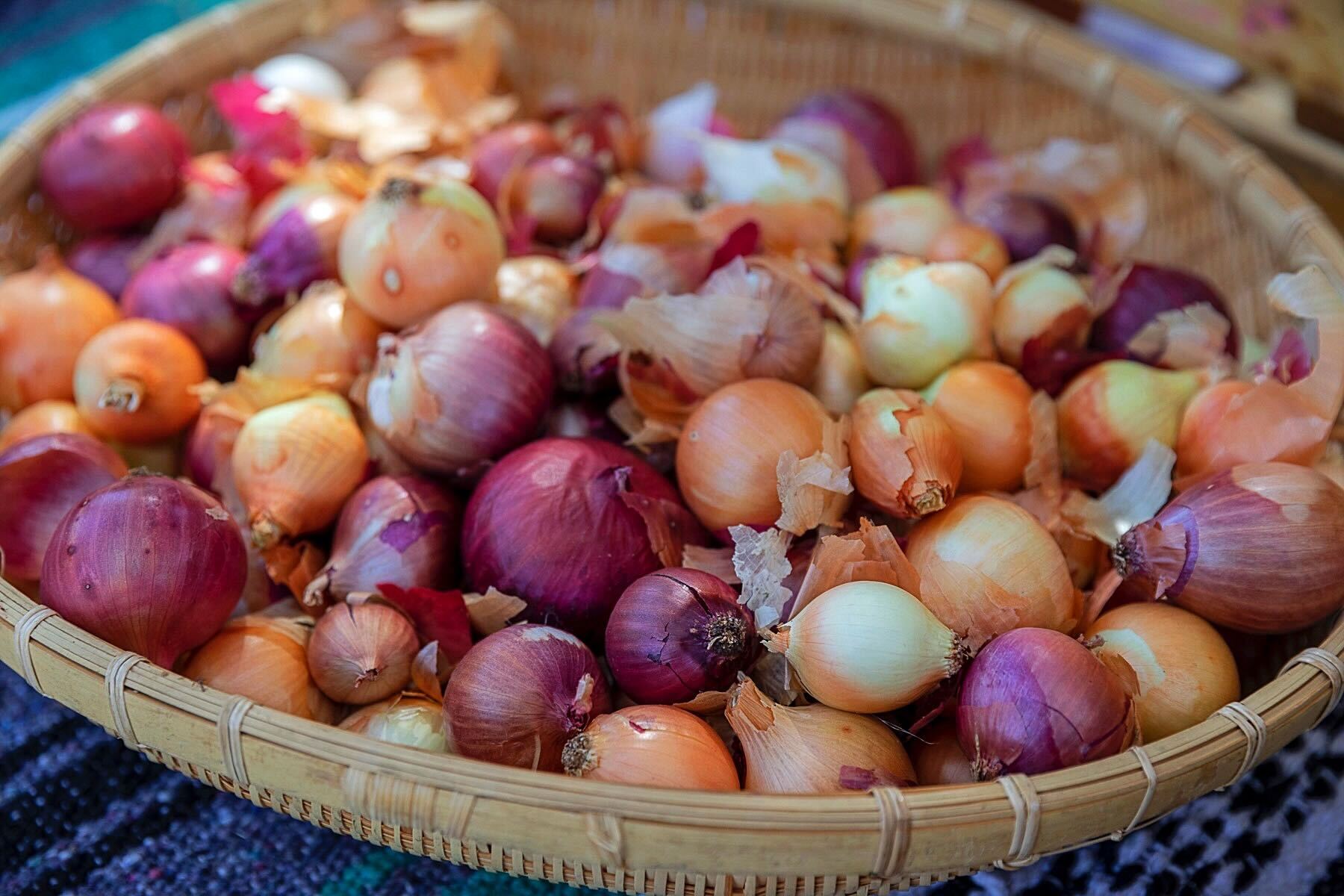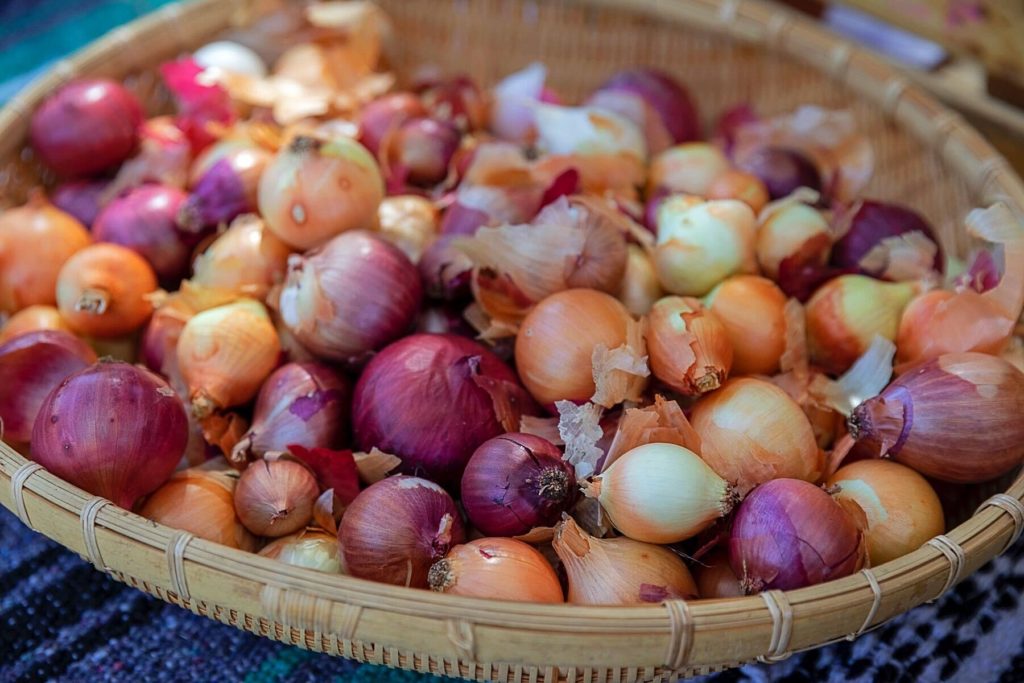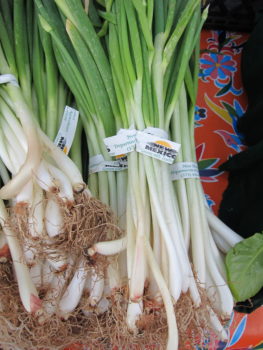
BY DENISE MILLER, NMFMA
When my onion drawer is empty, it usually means I’ve been cooking a lot. That’s because onions are integral to so many dishes from soups to salads that it’s easy to suddenly find your onion drawer waiting for a refill.
June is a great time to start finding onions at your nearby farmers’ market. Sweet and juicy, locally grown onions have their distinctive flavor thanks to a combination of natural genetics, minerals in the soil, and local weather that contribute to what the French call terroir.
Most onions go by a name akin to their color. Red, yellow, white, and even green is a common way to refer to onions. Some become popular enough to be called by their place name such as Vidalia (Georgia), Walla Walla (Washington),and New York Bold.
Conversely, some places have been named after onions.“Cebolla” is Spanish for onion, and Spanish-speaking settlers in New Mexico applied this word to numerous places, especially streams and valleys, because of the locally abundant wild onions. Cebolla in Rio Arriba, the Rio Cebolla, and Cebolla Valley in Mora are just a few examples.

Onions at ABQ. Downtown Growers’ Market by Gabriella Marks
Sweet Onions
In general, white onions are more strongly flavored than yellow onions, though depending on where they were grown, their flavor can vary with the season and from region to region.
At farmers’ markets, look for Candy or Texas Sweet onions, among other varieties. Plan to eat these raw to take advantage of their sweetness. Cooked they are also sweet and will add a delightful sweetness to any of your favorite recipes. Because they have a high moisture and high sugar content, they don’t store for long periods, so be sure to enjoy these special onions within a few weeks.
Storage Onions
Ideal for longer cooking dishes, these onions add depth of flavor to soups, stews, and casseroles. They become sweeter during cooking. These onions will last much longer due to their low moisture content. These are often harvested in the late summer and early fall, and then go through a curing period during which they dry out before their long storage. These are usually yellow, brown, or white.
Shallots & Scallions
Shallots are a mild onion variety that have the flavor qualities of both garlic and onions. They are about 1-1/2 to 2 inches long and slightly elongated. Local shallots are usually available at markets starting in late June when they are harvested. Like garlic, they are milder and juicier earlier in the season and develop their more intense flavor and storage capability with drying.
Scallions are often referred to as green onions. They are a variety of young onions with a long, thin white base that  has not yet developed into a bulb and long green stalks that look like giant chives. They have a milder flavor than mature onions but are a bit stronger than chives. Both the white base and the green stalks are eaten. They too can be found at many markets in early June. Farmers often harvest some of their onions early, and they look like large scallions. They can come in a variety of colors. Because the onions are young, both the bulb and the greens can be eaten.
has not yet developed into a bulb and long green stalks that look like giant chives. They have a milder flavor than mature onions but are a bit stronger than chives. Both the white base and the green stalks are eaten. They too can be found at many markets in early June. Farmers often harvest some of their onions early, and they look like large scallions. They can come in a variety of colors. Because the onions are young, both the bulb and the greens can be eaten.
Storing Onions
Onions are best kept in a cool dry place like a pantry or drawer away from excessive light or heat. Good air circulation will also help prevent spoilage. A firm onion will keep considerably longer than the sweet ones that may seem soft and moist at the outset. Onions should not be stored in the refrigerator because of the high moisture atmosphere.
And, while it’s common practice to store onions and potatoes together (guilty!), it’s not ideal as potatoes have a great deal of moisture and give off a gas that causes onions to spoil more quickly.
Never purchase onions that have begun to sprout greens from their stem portion. This indicates they are old, and they may have a bitter flavor. But if you see sprouts forming in your onions stored at home, simply snip them off and use them like chives, and use the onion sooner rather than later.
Peeling Without Tears
While there are many suggestions for avoiding tears when peeling an onion (like holding a match between your teeth or putting a piece of bread in your mouth), perhaps the best method is to plan ahead and put the onion in the refrigerator until it is cold. This seems to chill the volatile sulfur oils and prevent tears.
Raw, Roasted, Grilled
Whatever you do with onions, you can’t go wrong. Raw, sweet onions are delicious on a salad or blended into soup to lend a robust flavor. Add a bunch of scallions to a raw vegetable tray. Try this Zucchini Vichyssoise recipe for a refreshing cold soup made with sweet onions and summer squash. Hungry for more onion recipes? Find them on our seasonal recipe page.
Roasted onions are a treat. Slice onions about 1/4-inch thick and spread them out on a lightly oiled baking pan. Roast them at 375 to 400 degrees for about 25 to 35 minutes until they turn golden brown, turning them with a spatula every 10 to 15 minutes. Season if desired.
An enhanced version of roasted onions includes a light sprinkling of salt, a hint of dry red wine, and a few dashes of balsamic vinegar, taking care not to create too much liquid. Turn them frequently during roasting.
To grill a sweet onion, peel off the outer layer. Core the onion, leaving a cavity about one inch across and almost through to the bottom of the onion. Salt and pepper the onion cavity, then fill with butter. Sprinkle with salt and pepper, wrap in foil, gathering at the top and twisting to seal. Cook in closed grill for about 1 to 1-1/2 hours over medium indirect coals. Open foil 10 minutes before serving.
For faster-grilled onions, slice as if you were going to roast them, brush generously with olive or other oil, and grill at medium to low heat for 10-20 minutes.
Head to market and enjoy!
While New Mexico supplies more than 50 percent of the onions consumed in the United States during the months of June and July, most of the onions grown by these large producers in the southern part of the state are shipped out of state.
Luckily many of us can still enjoy New Mexico-grown onions brought to farmers’ markets by smaller producers. Most onions will be harvested by mid-September, but cured storage onions are usually available at markets into October. Find your nearest market here.
This season don’t shed any tears over an empty onion drawer: just head to market and talk to local growers about the foods they grow with love.
Denise Miller is executive director of the New Mexico Farmers’ Marketing Association. Visit newmexicofma.org/about.php

